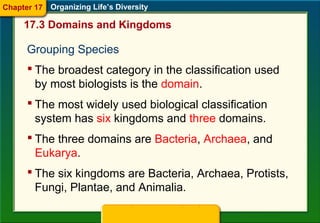17.3 domains and kingdoms
•Download as PPT, PDF•
1 like•463 views
17.3 domains and kingdoms
Report
Share
Report
Share

More Related Content
What's hot
What's hot (20)
Viewers also liked
Viewers also liked (20)
The theory of endosymbiosis says that eukaryote cells have evolved from a sym...

The theory of endosymbiosis says that eukaryote cells have evolved from a sym...
sStudy of mitosis in plants by using onion root tips cells

sStudy of mitosis in plants by using onion root tips cells
Similar to 17.3 domains and kingdoms
Similar to 17.3 domains and kingdoms (20)
Biology Ch. 17.ppt. Materi pokok, bahan pembelajaran

Biology Ch. 17.ppt. Materi pokok, bahan pembelajaran
More from Pickerington High School Central
More from Pickerington High School Central (17)
Recently uploaded
Mehran University Newsletter is a Quarterly Publication from Public Relations OfficeMehran University Newsletter Vol-X, Issue-I, 2024

Mehran University Newsletter Vol-X, Issue-I, 2024Mehran University of Engineering & Technology, Jamshoro
APM Welcome
Tuesday 30 April 2024
APM North West Network Conference, Synergies Across Sectors
Presented by:
Professor Adam Boddison OBE, Chief Executive Officer, APM
Conference overview:
https://www.apm.org.uk/community/apm-north-west-branch-conference/
Content description:
APM welcome from CEO
The main conference objective was to promote the Project Management profession with interaction between project practitioners, APM Corporate members, current project management students, academia and all who have an interest in projects.APM Welcome, APM North West Network Conference, Synergies Across Sectors

APM Welcome, APM North West Network Conference, Synergies Across SectorsAssociation for Project Management
Recently uploaded (20)
Unit-IV; Professional Sales Representative (PSR).pptx

Unit-IV; Professional Sales Representative (PSR).pptx
Presentation by Andreas Schleicher Tackling the School Absenteeism Crisis 30 ...

Presentation by Andreas Schleicher Tackling the School Absenteeism Crisis 30 ...
APM Welcome, APM North West Network Conference, Synergies Across Sectors

APM Welcome, APM North West Network Conference, Synergies Across Sectors
Unit-V; Pricing (Pharma Marketing Management).pptx

Unit-V; Pricing (Pharma Marketing Management).pptx
Z Score,T Score, Percential Rank and Box Plot Graph

Z Score,T Score, Percential Rank and Box Plot Graph
ICT Role in 21st Century Education & its Challenges.pptx

ICT Role in 21st Century Education & its Challenges.pptx
17.3 domains and kingdoms
- 1. Grouping Species The broadest category in the classification used by most biologists is the domain. 17.3 Domains and Kingdoms Organizing Life’s Diversity The most widely used biological classification system has six kingdoms and three domains. The three domains are Bacteria, Archaea, and Eukarya. The six kingdoms are Bacteria, Archaea, Protists, Fungi, Plantae, and Animalia. Chapter 17
- 2. Domain Bacteria Eubacteria are prokaryotes whose cell walls contain peptidoglycan. Organizing Life’s Diversity Eubacteria are a diverse group that can survive in many different environments. 17.3 Domains and Kingdoms Chapter 17
- 3. Domain Archaea Archaea are thought to be more ancient than bacteria and yet more closely related to our eukaryote ancestors. Organizing Life’s Diversity Archaea are diverse in shape and nutrition requirements. They are called extremophiles because they can live in extreme environments. 17.3 Domains and Kingdoms Chapter 17
- 4. Domain Eukarya All eukaryotes are classified in Domain Eukarya. Organizing Life’s Diversity Domain Eukarya contains: Kingdom Protista Kingdom Fungi Kingdom Plantae Kingdom Animalia 17.3 Domains and Kingdoms Chapter 17
- 5. Kingdom Protista Organizing Life’s Diversity Protists are classified into three different groups— plantlike, animal- like, and funguslike. Protists are eukaryotic organisms that can be unicellular, colonial, or multicellular. 17.3 Domains and Kingdoms Chapter 17
- 6. Kingdom Fungi Organizing Life’s Diversity A fungus is a unicellular or multicellular eukaryote that absorbs nutrients from organic materials in its environment. Member of Kingdom Fungi are heterotrophic, lack motility, and have cell walls. 17.3 Domains and Kingdoms Chapter 17
- 7. Kingdom Plantae Members of Kingdom Plantae form the base of all terrestrial habitats. Organizing Life’s Diversity All plants are multicellular and have cell walls composed of cellulose. Most plants are autotrophs, but some are heterotrophic. 17.3 Domains and Kingdoms Chapter 17
- 8. Kingdom Animalia All animals are heterotrophic, multicellular eukaryotes. Organizing Life’s Diversity Animal organs often are organized into complex organ systems. They live in the water, on land, and in the air. 17.3 Domains and Kingdoms Chapter 17
- 10. Viruses—An Exception A virus is a nucleic acid surrounded by a protein coat. Organizing Life’s Diversity Viruses do not possess cells, nor are they cells, and are not considered to be living. Because they are nonliving, they usually are not placed in the biological classification system. 17.3 Domains and Kingdoms Chapter 17
